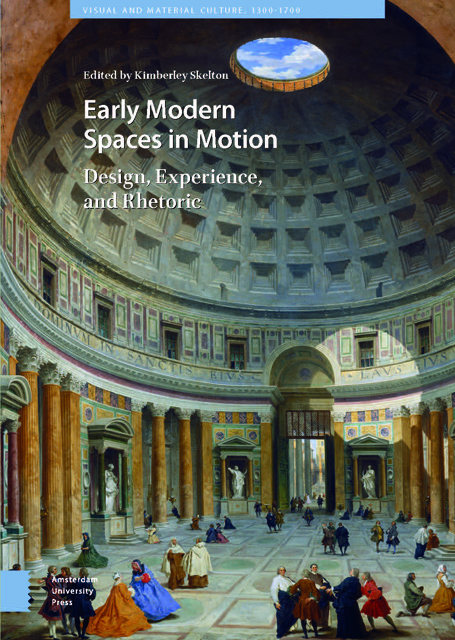Book contents
- Frontmatter
- Table of Contents
- List of Illustrations
- Acknowledgements
- Introduction: Bodies and Buildings in Motion
- 1 Navigating the Palace Underworld : Recreational Space, Pleasure, and Release at the Castello del Buonconsiglio, Trent
- 2 Passages to Fantasy : The Performance of Motion in Celliniâs Fontainebleau Portal and the Galerie François I
- 3 The Catholic Country House in Early Modern England : Motion, Pietyand Hospitality, c. 1580â1640
- 4 Sensory Vibrations and Social Reform at San Michele a Ripa in Rome
- 5 The Rise of the Staircase: Motion in Eighteenth-Century Dutch Domestic Architecture
- 6 Movement through Ruins: Re-experiencing Ancient Baalbek with Jean de la Roque
- 7 A Paper Tour of the Metropolis : The Architecture of Early Modern London in the Royal Magazine
- 8 Libraries in Motion: Forms of Movement in the Early Modern Library (1450-1770)
- Works Cited
- Index
2 - Passages to Fantasy : The Performance of Motion in Celliniâs Fontainebleau Portal and the Galerie François I
Published online by Cambridge University Press: 11 January 2023
- Frontmatter
- Table of Contents
- List of Illustrations
- Acknowledgements
- Introduction: Bodies and Buildings in Motion
- 1 Navigating the Palace Underworld : Recreational Space, Pleasure, and Release at the Castello del Buonconsiglio, Trent
- 2 Passages to Fantasy : The Performance of Motion in Celliniâs Fontainebleau Portal and the Galerie François I
- 3 The Catholic Country House in Early Modern England : Motion, Pietyand Hospitality, c. 1580â1640
- 4 Sensory Vibrations and Social Reform at San Michele a Ripa in Rome
- 5 The Rise of the Staircase: Motion in Eighteenth-Century Dutch Domestic Architecture
- 6 Movement through Ruins: Re-experiencing Ancient Baalbek with Jean de la Roque
- 7 A Paper Tour of the Metropolis : The Architecture of Early Modern London in the Royal Magazine
- 8 Libraries in Motion: Forms of Movement in the Early Modern Library (1450-1770)
- Works Cited
- Index
Summary
Abstract
In the early 1540s, King Francis I commissioned Benvenuto Cellini to design a bronze portal for the Porte Dorée at Fontainebleau. It consisted of a tympanum depicting the ‘Nymph of Fontainebleau’ in a forest setting. The imagery revived the foundation myth of Fontainebleau as a bountiful hunting ground and water source. Although it was never completed, Cellini’s design presented the forest beyond the doors as a recreational space for the varied motions of the hunting ritual and the palace behind the doors as a space for the more choreographed ambulatory motion of guided diplomatic tours. This essay explores the complementarity in the staging of interior and exterior as zones of visual and somatic pleasure.
Keywords: Cellini, Francis I, Fontainebleau, nymph, hunt, Porte Dorée
In the early 1540s, Benvenuto Cellini designed a bronze ensemble to frame the Porte Dorée, the main entrance to the Fontainebleau palace (Figure 10). The sculptural project featured a tympanum depicting the ‘Nymph of Fontainebleau’ in a forest setting with hunting dogs, a prominent stag head, and wild creatures. Although several scholars have explored Cellini’s project in detail, further investigation of its site-specific meaning is warranted. Previous interpretations have addressed the biographical role of the tympanum in Cellini’s transition from goldsmith to sculptor, as well as its role in his rise as a court artist. Studies of the iconography have noted all’antica influences and identified allegorical subtexts that shed light on relationships among the king, Cellini, and Cellini’s mistress. In part because the project was never installed or completed, a fresh examination can help us reimagine the intended uses and associations of this work in situ. This essay will examine the portal’s planned location as a point of intersection for different modalities of circulation that occurred at Fontainebleau: interior and exterior, formal and informal, fast and slow, walking and riding horseback while engaged in the hunt. Seen together, these various forms of motion shaped the experiences of visitors and allowed Francis I to perform his royal persona.
Fontainebleau: The Renewal of the Palace and the Revival of the Foundation Myth
Cellini’s portal was to occupy the lunette space beyond the archway and porch, the recessed area around the doors leading into the vestibule.
- Type
- Chapter
- Information
- Early Modern Spaces in MotionDesign, Experience and Rhetoric, pp. 59 - 80Publisher: Amsterdam University PressPrint publication year: 2020



